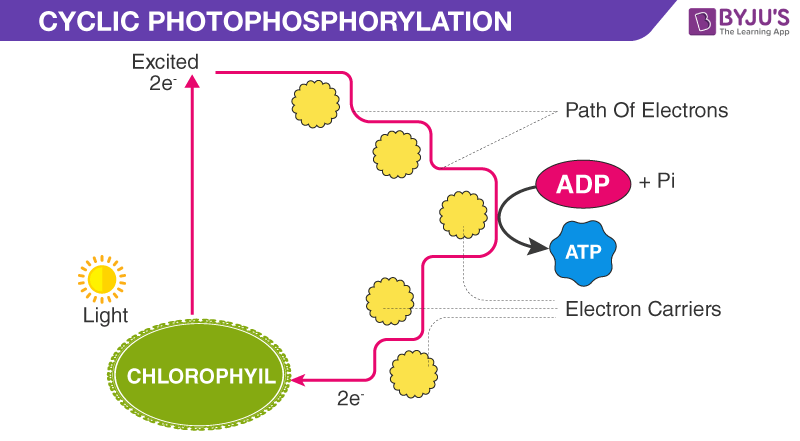We all are well aware of the complete process of photosynthesis. Yes, it is the biological process of converting light energy into chemical energy. In this process, light energy is captured and used for converting carbon dioxide and water into glucose and oxygen gas. The complete process of photosynthesis is carried out through two processes:
Light reaction
The light reaction takes place in the grana of the chloroplast. Here, light energy gets converted to chemical energy as ATP and NADPH. In this very light reaction, the addition of phosphate in the presence of light or the synthesizing of ATP by cells is known as photophosphorylation.
Dark reaction
While in the dark reaction, the energy produced previously in the light reaction is utilized to fix carbon dioxide into carbohydrates. The location where this happens is the stroma of the chloroplasts.
Photophosphorylation
Photophosphorylation is the process of utilizing light energy from photosynthesis to convert ADP to ATP. It is the process of synthesizing energy-rich ATP molecules by transferring the phosphate group into ADP molecule in the presence of light.
Photophosphorylation is of two types:
- Cyclic Photophosphorylation
- Non-cyclic Photophosphorylation
Cyclic Photophosphorylation

Cyclic Photophosphorylation
The photophosphorylation process which results in the movement of the electrons in a cyclic manner for synthesizing ATP molecules is called cyclic photophosphorylation.
In this process, plant cells just accomplish the ADP to ATP for immediate energy for the cells. This process usually takes place in the thylakoid membrane and uses Photosystem I and the chlorophyll P700.
During cyclic photophosphorylation, the electrons are transferred back to P700 instead of moving into the NADP from the electron acceptor. This downward movement of electrons from an acceptor to P700 results in the formation of ATP molecules.
Non-Cyclic Photophosphorylation

Non-cyclic Photophosphorylation
The photophosphorylation process which results in the movement of the electrons in a non-cyclic manner for synthesizing ATP molecules using the energy from excited electrons provided by photosystem II is called non-cyclic photophosphorylation.
This process is referred to as non- cyclic photophosphorylation because the lost electrons by P680 of Photosystem II are occupied by P700 of Photosystem I and are not reverted to P680. Here the complete movement of the electrons is in a unidirectional or in a non- cyclic manner.
During non-cyclic photophosphorylation, the electrons released by P700 are carried by primary acceptor and are finally passed on to NADP. Here, the electrons combine with the protons – H+ which is produced by splitting up of the water molecule and reduces NADP to NADPH2.
Also Read: Photosynthesis
Difference between Cyclic and Non-Cyclic Photophosphorylation
Following are the important differences between cyclic and non-cyclic photophosphorylation:
| Cyclic Photophosphorylation | Non-Cyclic Photophosphorylation |
| Only Photosystem I is involved. | Both Photosystem I and II are involved. |
| P700 is the active reaction centre. | P680 is the active reaction centre. |
| Electrons travel in a cyclic manner. | Electrons travel in a non – cyclic manner. |
| Electrons revert to Photosystem I | Electrons from Photosystem I are accepted by NADP. |
| ATP molecules are produced. | Both NADPH and ATP molecules are produced. |
| Water is not required. | Photolysis of water is present. |
| NADPH is not synthesized. | NADPH is synthesized. |
| Oxygen is not evolved as the by-product | Oxygen is evolved as a by-product. |
| This process is predominant only in bacteria. | This process is predominant in all green plants. |
Also Read: Plant Cell
To learn more about cyclic and non cyclic photophosphorylation and the difference between cyclic and non cyclic photophosphorylation, keep visiting the BYJU’S website or download BYJU’S app for further reference.

It’s useful
Thanks a lot
This is an excellent
your notes make me understand
Simply nice to understand
Its very helpfull tnx a lot🤗
Thankuuu so much … it is in very easy language to study
easy to understand + consists of useful infomation………excellent….i love learning with BYJU’S…
its useful
It is very helpful and simply nice to understand
This is very helpful thanks
Easy to understanding the concept, it’s very usefull
Easy and good to understand for first time learners of this concept
Excellent explained
very nice
I found it best
Ur notes r easy to understand and consist of a lot of useful information and It’s very very useful n helpful🤗. Thanks a lot 🙏🏻. I love learning with BYJUS.
) Pointwise answer
) useful information
) Colourful diagrams
) Just read-and-done short material
Thank You So Much For Providing Me This Very Useful And Important Notes
The notes are very easy to understand,and it is really helpful.
It is very helpful to beginners. Overview of photosynthesis